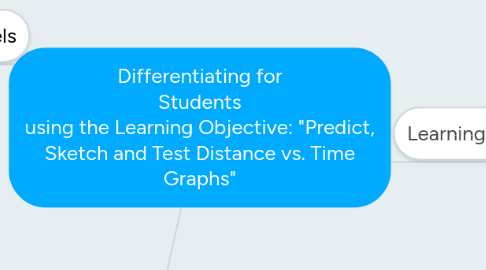
1. Interests
1.1. Exercise
1.1.1. These students are really motivated by exercise and sports. How can we differentiate for them?
1.1.1.1. Promote Choice
1.1.1.1.1. Here is a link where you can see examples of ways students to give your students more choice
1.1.1.1.2. Use graphing examples from several different sports and types of exercise.
1.1.1.2. 21st Century Technology: Have students analyze motion graphs from looking at sports videos
1.2. Driving
1.2.1. These students are really motivated by driving. How can we differentiate for them?
1.2.1.1. 21st Century Technology: Have students collect data using motion sensors in their phone or from the Vernier equipment we have at school when they are riding in the passenger seat of their parents car from school to home. Later they would graph their data and explain the results they have collected.
2. Readiness Levels
2.1. Level 4 Expanding
2.1.1. How can I differentiate for students who are in Level 4 Expanding?
2.1.1.1. 21st Century Technology that I would be using would be the use of PhET simulations from the University of Colorado and videos from the University of New South Wales.
2.1.1.2. Provide ongoing scaffolding using visuals, especially when introducing new concepts. For this objective in addition to using the PhET Simulation I would also use several videos from the University of New South Wales to show how motion graphs are created using the motion of objects.
2.1.1.3. Encourage students to speak in class to explain the motion they are seeing in the PhET simulation and the videos from the University of New South Wales
2.2. Level 3 Developing
2.2.1. How can I differentiate for students who is in Level 3 Developing?
2.2.1.1. Provide content support in their native language when necessary. Students would have access to the Internet and to online dictionaries.
2.2.1.2. Provide ongoing scaffolding using visuals in both small and large groups. The data collection activity of collecting data of a moving person would be done in large groups, while the PhET simulation could be done in small groups.
2.2.1.3. Provide individual scaffolding when necessary. This could be done as a graph with written help on how to graph and plot data.
2.2.1.4. Encourage ELL students to respond in English both verbally and in written form. Students would need to verbalize and write about the motion shown on the graphs in English.
2.2.1.5. 21st Century Technology that could be used in the lesson would be online dictionaries and Google Translate. This would allow the student to look up words and for me to communicate better with them when there was a misunderstanding.
3. Learning Profiles
3.1. Visual Learners
3.1.1. Some students are visual learners and learn better through the use of pictures, images or spatial understanding. How can I differentiate for these types of students?
3.1.1.1. For this objective I would use PhET simulations to show the relationship between the motion of a man and the distance vs. time graph that is being created by the simulation
3.1.1.2. For this objective I would also have the students collect data of a person running over the course of a 25 m distance and have them plot their results on a graph.
3.2. Verbal Learner
3.2.1. Some students are verbal learners and learn better through the use of words both in speech and writing. How can I differentiate for these types of students?
3.2.1.1. For this objective I would have students verbally explain the relationship they are seeing in a graph that they have created from the 25 m activity mentioned above. Once they have verbalize their results, I would also have them write about the motion of their peer over the 25 m distance
3.2.1.2. For this objective I would have the students verbally explain the motion shown in the PhET simulation and then have them write about the motion they observed.

